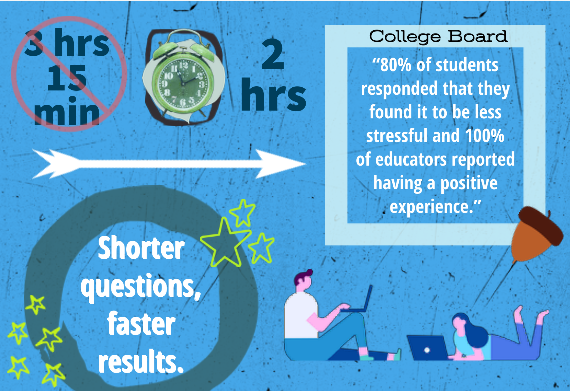
Digital SAT will prove more advantageous for high school students
February 18, 2022
For many students, I myself included, the SAT is the academic equivalent of a seemingly endless nightmare. Three long, taxing hours spent shading in empty bubbles and doubting your mental sanity is generally the most dreaded event of one’s high school career. That said, the College Board’s upcoming change to the exam’s structure might be the dawn of a significantly more reassuring era for high school students.
Because of COVID-19, hundreds of universities around the nation are now test-optional, making the infamous SAT noticeably less relevant for college admissions. As a result, the College Board will administer the SAT digitally beginning as early as 2023. The shift to a digital exam is one of the smartest, most beneficial decisions the College Board has ever made for several reasons.
One of the most apparent advantages of the digital SAT for students is its shorter duration. As opposed to the current SAT, which takes three hours and 15 minutes, the digital SAT will be closer to two hours. In addition, according to SAT organizers, the shorter time of the digital exam will enable students to spend more time on each question due to briefer reading passages and more direct questions.
At the same time, most high school students nowadays work and perform best using technology—especially given their extensive experience using computers during remote learning. Additionally, with the ever-increasing popularity of personal devices, video games and social media, many present-day high school students experience a sense of comfort and structure using technology. To take that away from them and push the old-fashioned pencil and paper method of testing on them is like forcing an orchestra to perform without a conductor—the results could be disastrous.
Still, combining test-taking with technology comes with some complications. For instance, in 2016, Assistant Clinical Professor at the University of Maryland Lauren M. Singer Trakhman had undergraduates read both a printed and a digital article. After they finished, Singer Trakhman analyzed their comprehension and concluded they missed specific details when reading online. Likewise, another study found that students perform better on paper exams than on digital exams.
That said, such findings are flawed when looking at the impacts stress has on students taking the SAT. One feature of the paper SAT that will always stick with me is the extreme amount of pressure I felt during it, which was unlike any amount of stress I’ve felt when taking any other test—even, I would argue, the dreaded AP exams. Between the seemingly impossible time constraints and the complex questions that leave students desperately torn between two answers, the test is mentally and emotionally taxing, to say the least.
The adrenaline rush that comes with this anxiety can cause students to make mistakes and look over the content too quickly, resulting in the poorer comprehension Singer Trakhman indicated. Likewise, making mistakes in math could also be applied to SAT-generated stress, thus straining the accuracy of the previous statement that students score higher on math when taking paper exams.
Eliminating the paper SAT will promote student success and put an end to the unnecessary pressure the paper version produced. Adopting the digital SAT is another step in developing a modern world that takes student needs and desires into further account and will only lead to a more enjoyable, worthwhile high school experience.